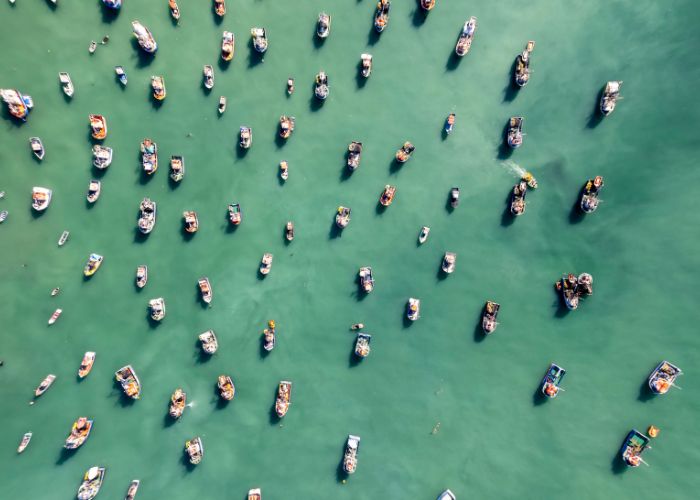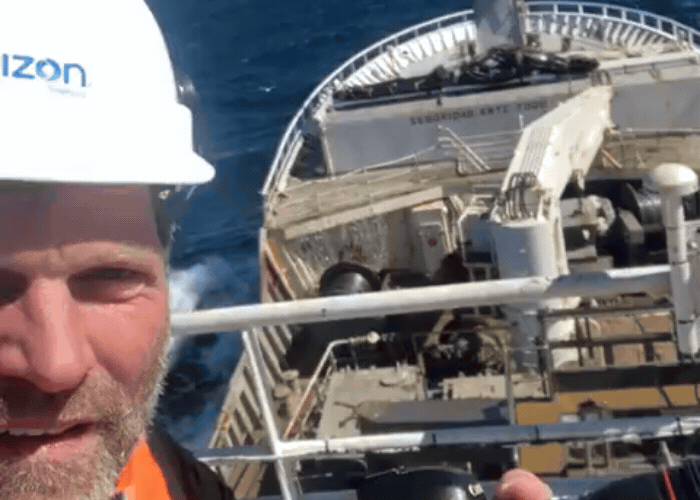Working on corporate projects has always been a mix of challenges and satisfactions. Alongside Orizon Seafood, I had the unique opportunity to immerse myself in the world of high-seas fishing, documenting the hard work of the fishermen. This project not only allowed me to showcase my technical and creative skills but also my adaptability to extreme circumstances. Here, I share with you the experience of filming this video, the challenges faced, and the lessons learned in the process.
Technical Challenges in the Cold and Darkness of the Pacific
The logistics of filming at sea involve conditions that cannot be controlled, and the Pacific presented us with its most challenging face. One of the first obstacles was working in the cold of Orizon Seafood’s factory. The low temperatures caused the camera lenses to constantly fog up, a problem that required continuous cleaning and preparation to ensure clear and sharp shots.
Drone technology has become an invaluable tool for filmmakers, but flying a drone in the middle of the Pacific, at night, and with strong winds, was a test of precision and control. Each takeoff and landing required meticulous planning and nerves of steel, especially considering that any mistake could result in the loss of the equipment in the vast ocean. Despite these difficulties, we managed to capture impressive aerial images that convey the magnitude and beauty of the marine environment.

Another significant challenge was filming aboard the fishing boats during the day. The constant movement of the vessel due to the waves not only made it difficult to maintain camera stability but also put the equipment at risk due to continuous splashing from the seawater. This unstable and wet environment required special protection for the equipment and a quick adaptation ability to capture the best shots at the right moments.
Adaptation as the Key to Success

My experience in reporting and documentaries has been crucial in facing these adversities. In this type of work, one rarely controls the weather or external factors. It is about learning to adapt quickly to changing conditions and finding creative solutions on the fly. This ability became my greatest ally during the production of the video for Orizon Seafood.
For instance, in situations where the wind made it impossible to fly the drone, we opted for captures from less conventional angles, using portable cameras and stabilizing mounts to ensure smooth and fluid shots. Additionally, coordination with the team of fishermen and factory workers was essential. Their knowledge of the environment and their collaboration allowed us to access key areas and capture authentic and significant moments.
Flexibility and adaptability also extended to post-production. Often, footage captured in extreme conditions requires special treatment during editing. Color correction and exposure adjustment were vital to ensure that each scene reflected the reality of the environment and the dedication of the workers.
Portraying the Story of the Fish: From Sea to Table
The main objective of the video was to show the complete process of how a highly nutritious and healthy fish reaches the consumer’s table from the depths of the ocean. This narrative needed to be powerful and engaging, highlighting each stage with visual and emotional details.
Filming began at the heart of the process: on Orizon Seafood’s fishing boats. Documenting life aboard these boats was a revealing experience. The fishermen, with their experience and dedication, work long hours in demanding conditions to ensure the best quality of the fish. Capturing their daily routine, from fishing to sorting the catch, was essential to showcase the company’s commitment to sustainability and excellence.
In the factory, precision and advanced technology combine to process the fish efficiently and maintain its freshness. We filmed the meticulous work of the employees overseeing each step of the process, ensuring that each piece of fish meets Orizon Seafood’s high-quality standards. Here, the technical challenge of keeping the equipment functioning in a cold and humid environment was constant, but the result was worth every effort.

Finally, we moved to the homes and restaurants where Orizon Seafood products are enjoyed. We filmed chefs and consumers preparing and tasting the fish, capturing their reactions and positive comments. This segment was crucial to emotionally connect with the audience, showing how the fish is not only a healthy food but also a culinary delight appreciated by many.
The Value of Well-Done Work
Reflecting on this experience, I realize how rewarding it was to overcome technical and logistical challenges to create a video that not only meets but exceeds the client’s expectations. The satisfaction of seeing the final product and receiving positive feedback from Orizon Seafood and their customers was immense.
The success of this project is largely due to the collaboration and joint effort of the entire team, from the fishermen to the factory staff, and the trust that Orizon Seafood placed in our vision. Every obstacle overcome, from the factory’s cold to the Pacific’s winds, reinforced the importance of adaptability and perseverance in a filmmaker’s work.
Ultimately, filming this corporate video was a valuable lesson in resilience and creativity under pressure. The ability to adapt to adverse conditions and find innovative solutions not only made the production of this video possible but also strengthened my skills and passion for telling authentic and powerful stories through the camera lens.
Orizon Seafood, with its commitment to quality and sustainability, gave me the opportunity to show the world the value of their product as a healthy and delicious food option. I am grateful for this experience and eager for the next challenges that the world of corporate filmmaking may bring.
